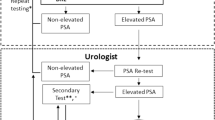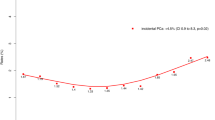Abstract
The aim of this study was to study the incidence and possibility of prostate cancer detection in patients <50 years with prostate-specific antigen (PSA) <4 ng ml−1. Between January 2006 and January 2008, 355 men were subjected to radical cystoprostatectomy for bladder cancer. Among 162 cases without pathological prostatic invasion, random selection of two groups with serum PSA <4 ng ml−1 was carried out. According to the age, 56 pairs in group A (⩽50 years) and group B (>50 years) were selected randomly. The resected prostate glands of each group were examined pathologically for evidence of prostatic adenocarcinoma. Correlation of the age groups with pathological findings, PSA, digital rectal examination (DRE) and body mass index (BMI) was carried out. The mean age of the groups (A and B) was 46.17±4.3 and 58.42±4.4 years, respectively. Mean PSA was 1.9±1.6 ng ml−1 in group A and 2±1.6 ng ml−1 in group B. Prostatic adenocarcinoma was detected in 1.8 and 10.7% in groups A and B, respectively (P=0.051). High-grade prostatic intraepithelial neoplasia (PIN) was higher in group A than in group B, 11 cases versus 4 (P=0.079). DRE was not significantly associated with pathological findings in those groups of patients. BMI was directly correlated with PSA in patients of group A (mean: 27.8±4.4, CC: 0.5, P=0.015), but not with that of group B (mean: 27.5±4.8, CC: 0.16, P=0.239). A new PSA cut-off point for younger patients (<50 years) is warranted. Serum PSA 2 ng ml−1 is recommended as a cut-off point to screen and biopsy advice for nonsymptomatic patients <50 years. High-grade PIN was higher among the younger patients with low serum PSA, which indeed needs a meticulous follow-up.
This is a preview of subscription content, access via your institution
Access options
Subscribe to this journal
Receive 4 print issues and online access
$259.00 per year
only $64.75 per issue
Buy this article
- Purchase on Springer Link
- Instant access to full article PDF
Prices may be subject to local taxes which are calculated during checkout
Similar content being viewed by others
References
Schmid HP, Riesen W, Prikler L . Update on screening for prostate cancer with prostate-specific antigen. Crit Rev Oncol Hematol 2004; 50: 71–78.
Hankey BF, Feuer EJ, Clegg LX, Hayes RB, Legler JM, Prorok PC et al. Cancer surveillance series: interpreting trends in prostate cancer. Part I: evidence of the effects of screening in recent prostate cancer incidence, mortality, and survival rates. J Natl Cancer Inst 1999; 91: 1017–1024.
Chodak G . Conservative management of clinically-localized prostate cancer. Can J Oncol 1994; 4 (Suppl 1): 20–23.
Smith CV, Bauer JJ, Connelly RR, Seay T, Kane C, Foley J et al. Prostate cancer in men age 50 years or younger: a review of the Department of Defense Center for Prostate Disease Research multicenter prostate cancer database. J Urol 2000; 164: 1964–1967.
Catalona WJ, Ramos CG, Carvalhal GF, Yan Y . Lowering PSA cutoffs to enhance detection of curable prostate cancer. Urology 2000; 55: 791–795.
Oesterling JE, Jacobsen SJ, Chute CG, Guess HA, Girman CJ, Panser LA et al. Serum prostate-specific antigen in a community-based population of healthy men. Establishment of age-specific reference range. JAMA 1993; 270: 860–864.
Moul JW, Connelly RR, Barko WF, Viatkus M . Should healthy men between the age of 40–49 be screened for prostate cancer: A Department of Defense (DOD), Center for Prostate Disease Research (CPDR), and Army Physical Fitness Research Institute (APFRI) Prospective Study at the U.S. Army War college (USAWC). J Urol 2000; 163 (Suppl.): 90 (Abstract #393).
Sun L, Moul JW, Hotaling JM, Rampersaud E, Dahm P, Robertson C et al. Prostate-specific antigen (PSA) and PSA velocity for prostate cancer detection in men aged <50 years. BJU Int 2007; 99: 753–757.
Denmeade SR, Isaacs JT . The role of prostate-specific antigen in the clinical evaluation of prostatic disease. BJU Int 2004; 93 (Suppl. 1): 10–15.
Carter HB, Pearson JD, Metter EJ, Brant LJ, Chan DW, Andres R et al. Longitudinal evaluation of prostate specific antigen levels in men with and without prostate disease. JAMA 1992; 267: 2215–2220.
Thompson IM, Pauler DK, Goodman PJ, Tangen CM, Lucia MS, Parnes HL et al. Prevalence of prostate cancer among men with a prostate-specific antigen level < or =4.0 ng per milliliter. N Engl J Med 2004; 350: 2239–2246.
Jacobsen SJ, Jacobson DJ, Girman CJ, Roberts RO, Rhodes T, Guess HA et al. Treatment for benign prostatic hyperplasia among community dwelling men: the Olmsted County study of urinary symptoms and health status. J Urol 1999; 162: 1301–1306.
Gann PH, Hennekens CH, Stampfer MJ . A prospective evaluation of plasma prostate-specific antigen for detection of prostate cancer. JAMA 1995; 273: 289–294.
Labrie F, Dupont A, Suburu R, Cusan L, Tremblay M, Gomez JL et al. Serum prostate specific antigen as pre screening test for prostate cancer. J Urol 1992; 147: 846–852.
Littrup PJ . Prostate cancer screening—appropriate choices? Cancer Suppl 1994; 74: 2016–2022.
Catalona WJ, Smith DS, Ornstein DK . Prostate cancer detection in men with serum PSA concentrations of 2.6 to 4 ng/mL and benign prostate examination: enhancement of specificity with free PSA measurements. JAMA 1997; 277: 1452–1455.
Colberg JW, Smith DS, Catalona WJ . Prevalence and pathological extent of prostate cancer in men with prostate specific antigen levels of 2.9 to 4 ng/mL. J Urol 1993; 149: 507–509.
Schroder FH, van der Cruijsen-Koeter I, de Koning HJ, Vis AN, Hoedemaeker RF, Kranse R . Prostate cancer detection at low values of prostate specific antigen (PSA). J Urol 2000; 163: 806–811.
Smith DS, Catalona WJ, Herschman JC . Longitudinal screening for prostate cancer with prostate-specific antigen. JAMA 1996; 276: 1309–1315.
Ando R, Nagaya T, Hashimoto Y, Suzuki S, Itoh Y, Umemoto Y et al. Inverse relationship between obesity and serum prostate-specific antigen level in healthy Japanese men: a hospital-based cross-sectional survey, 2004–2006. Urology 2008; 72: 561–565.
Price MM, Hamilton RJ, Robertson CN, Butts MC, Freedland SJ . Body mass index, prostate-specific antigen, and digital rectal examination findings among participants in a prostate cancer screening clinic. Urology 2008; 71: 787–791.
Kim YJ, Han BK, Hong SK, Byun SS, Kim WJ, Lee SE . Body mass index influences prostate-specific antigen in men younger than 60 years of age. Int J Urol 2007; 14: 1009–1012.
Author information
Authors and Affiliations
Corresponding author
Rights and permissions
About this article
Cite this article
Hekal, I. The patients less than 50 years: is there a need to lower the PSA cutoff point?. Prostate Cancer Prostatic Dis 12, 148–151 (2009). https://doi.org/10.1038/pcan.2008.48
Received:
Revised:
Accepted:
Published:
Issue Date:
DOI: https://doi.org/10.1038/pcan.2008.48
Keywords
This article is cited by
-
Contribution of Genetic Variation rs266882 to Prostate-Specific Antigen Levels in Healthy Controls with Serum PSA Below 2.0 ng/ml
Biochemical Genetics (2013)
-
Obesity–PSA relationship: a new formula
Prostate Cancer and Prostatic Diseases (2010)



